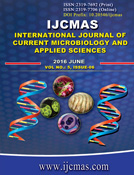


 National Academy of Agricultural Sciences (NAAS)
National Academy of Agricultural Sciences (NAAS)

|
PRINT ISSN : 2319-7692
Online ISSN : 2319-7706 Issues : 12 per year Publisher : Excellent Publishers Email : editorijcmas@gmail.com / submit@ijcmas.com Editor-in-chief: Dr.M.Prakash Index Copernicus ICV 2018: 95.39 NAAS RATING 2020: 5.38 |
Constructed wetland treatments are engineered systems that have been designed and constructed to utilize the wetland vegetation, soils and microbial populations to treat contaminants from surface water, ground water and wastewater. The use of constructed wetlands to treat wastewater is rapidly emerging as a feasible alternative at worldwide. A pilot scale study was conducted to examine the feasibility study and impact of plant density on the sewage treatment through selected wetland rooted plant species using Angular Horizontal Subsurface Flow (AHSSF) constructed wetland. In the present study 100 % sewage concentration and Cana indica, Pannicum maximum, Colocasia esculenta, Typha latifolia, Pennisetum purpureium Schumach and Eichhornia crassipes of plant species were used and planted in equal numbers in the media bed and examined its impact on the sewage treatment. In this investigation only plant growth and pollutants removal efficiency was studied in various seasons during sewage treatment. In this overall study the Pennisetum purpureium of emergent and Eichhornia crassipes of free floating plants removed greatest and maximum organic and inorganic pollutants from the sewage. The constructed wetland bed of all plants shows greenery, leafier and seems flowering and also most of the faunal species were attracted towards the experimental bed.
 |
 |
 |
 |
 |